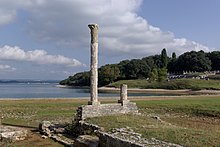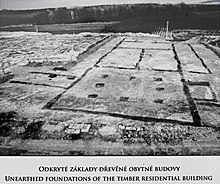Anton Gnirs
Anton Gnirs (* 18th January 1873 in Saaz ; † 10. December 1933 in Elbogen ) was a German- Bohemian teacher, archaeologist, restorer, archivist, historian and preservationist. He is one of the most important archaeologists in the provinces of the Habsburg monarchy . Its importance lies in the research and preservation of prehistoric and Roman antiquities in Istria , Carniola , Bohemia and Moravia .
Life
Anton Gnirs was born as the son of Anton Gnirs and his wife Mathilde, geb. Schwarzbach, born in Saaz. The family later moved to Chomutov , where his father was the director of Northwest Bohemian Coal Ltd. He attended high school in Komotau, where he graduated from high school in 1893. He then began studying at the Karl Ferdinand University in Prague. He initially studied German, history and geography, later he studied art history, classical antiquity and archeology. In 1899 he completed his studies with the teaching examination and was a brief teacher at the pilot plant in Pilsen .
Istria 1899-1918
In September 1899 he began teaching at the Naval School in Pola , and a year later he became a full professor. In 1902 he was appointed curator of the Central Commission for Research and Conservation of Art and Historical Monuments in the Istrian Districts of Pola, Rovigno and Pisino . In 1903 he completed his studies with a doctorate in philosophy at the Karl Ferdinand University in Prague and went on a study trip through Italy, Greece and Asia Minor. From 1904 he began excavations in Pola, on the island of Brioni, as well as in Fasana and Banjole . The most important excavation objects in Pula were the Porta Aurea and the Porta Gemina as well as the ancient theater and on the island of Brioni a Roman-Hellenistic luxury villa.
In 1907 he became a professor at the state secondary school in Pola and a year later rector of this school. In 1909 he was appointed director of the State Collections of Antiquities in Pola and was released from teaching so that he could devote himself entirely to the archaeological excavations. He earned great services in the recovery and securing of art treasures.
In 1912 he was appointed state curator for Istria , based in Pola, and from 1915–1918 also for the former duchies of Carinthia and Carniola based in Ljubljana. He was also on the state advisory board for the reconstruction of the county of Gorizia and Gradisca . During the First World War he secured the art treasures in the areas endangered by the Isonzo Front . After the First World War he worked in the Armistice Commission in Vienna until 1919. In 1917 he married Margarete Stein, daughter of Hugo Stein, from Annahof near Komotau.
He has continuously published his rich research results from Istria from early history to the Dane times of Venice in numerous treatises of the various institutes in Vienna. In addition, he devoted himself to researching early Christian monuments until 1918, whereby he was able to establish strong relationships with the rural architecture of the Romans . During the war he was able to uncover the monumental mosaic surfaces of the basilica in Aquileia, uncover a Christian cult complex from the Constantinian era and publish the results.

The most important work results of Anton Gnirs from 1901 to 1918 were (according to Hans Klein in a bibliography from 1931):
- The investigation of the rural architecture of the Romans, from the small economic cell of the " villa rustica " to the large mansion of the first century AD. To do this, he carried out excavations at the Roman villas of Val Catena, Val Bandon and in Medolino . In doing so, he succeeded in uncovering the foundations of temples, hall fronts, port facilities and other buildings, as well as the ancient facilities of a technically perfect water supply.
- Between 1902 and 1907 he dealt with questions about the beach shifts of the Adriatic , which have been observable since historical times , the results of this research being published in the publications of the Vienna Geographical Society.
- In the years up to 1914 - due to the heavy building activity in Pola - he was able to uncover numerous archaeological finds, e. B. a pre-Roman burial place and a Hellenistic stage theater from Augustan times on the north slope of the Capitol.
Czechoslovakia 1918–1933
In 1919 he returned to his homeland and was accepted into the school service by the Czechoslovak government. From September 1, 1919, he began his work as a professor of German history and geography at the state secondary school in Elbogen . Here he developed various cultural activities. In 1921 he founded the city library and in 1923 became director of the city museum and the city archive. In 1925 he received an exemption from the Czechoslovak Ministry of Culture in order to be able to devote himself to his scientific work and to work for the Czechoslovak Archaeological Institute in the excavations of prehistoric and ancient sites in Czechoslovakia. Excavation sites were u. a .:
- Schlada near Franzensbad (Copper Age and Bronze Age) from 1926 to 1930
- Sirmitz , district of Franzensbad, (Late Bronze Age) from 1929 to 1930
- Hradisko (castle stables) near the village of Mušov (Muschau) in South Moravia (remains of a Roman camp from the 2nd century and Roman facilities in the South Moravian Limes foreland) from 1927 to 1928
- Stupava (stamping) in Slovakia
- Cheb Castle (archaeological work on the castle) from 1930 to 1933
- prehistoric sites in western Bohemia (1933)
He died on December 10, 1933 in Loket and was buried in the family crypt of the Stein family in the city cemetery in Chomutov. In 1935 a tombstone by the sculptor Willy Russ was erected on his grave .
Memberships and honors
- Member of the Austrian Archaeological Institute in Vienna (1901)
- Corresponding member of the Société française d'archéologie in Paris (1906)
- Member of the German Archaeological Institute in Berlin (corresponding member 1912, full member 1921)
- Founding member of the Association of German Ethnographic Museums in Czechoslovakia (1923)
- Member of the Archaeological Institute in Prague (1925)
- Member of the German Society of Sciences and Arts in Prague
- Member of the Association for the History of Germans in Bohemia
- Knight's Cross of the Franz Joseph Order
- Holder of the Saxon Order of Albrecht
- Honorary citizen of Karlsbad
Publications (selection)
See the complete list of publications in Anna Gnirs (ed.): Anton Gnirs: Contributions to the history and geography of Bohemia and Moravia in the time of the Roman Empire . Publishing house Wiss. Archive. Bonn, 1976, pp. 141-152.
- Eastern Germania and its traffic routes in the representation of Ptolemy. A contribution to the ancient geography of Germania (Prague studies in the field of historical science), Rohlíček and Sievers, Prague 1898
- The territory of the Istrian peninsula in ancient lore. In: Annual report of the kuk Marine-Unterrealschule in Pola 1901/1902. Pola 1902
- Early Christian cults in southern Istria. In: Yearbook of the Art History Institute of the kk Central Commission for Monument Preservation. 5, pp. 1-48 (1911)
- Pola. A guide to the ancient monuments and collections. Vienna 1915
- Austria's fight for its southern region on the Isonzo 1615–1617. As a chronicle of the Second Friulian War according to contemporary sources. Vienna 1916
- Old and new church bells: With contributions to the history of bell casting and its masters in the areas north and south of the Eastern Alps and on the Adriatic, Karlsbad; Leipzig: W. Heinisch, 1924
- Karlovy Vary in its oldest past. Traditions, monuments and documents, Karlsbad; Leipzig: W. Heinisch, 1925 (Freiburg reprint: Freiburger-Echo-Verlag, 2001, ISBN 3-86028-057-0 )
- Istria praeromana. Contributions to the history of the earliest and pre-Roman cultures on the coasts of the northern Adriatic. Carlsbad 1925
- A mountain chronicle of the cities of Schlaggenwald and Elbogen, 1926
- The Elbogen political district, Prague: German Society of Sciences and Arts, 1927
- Elbogen near Karlsbad. A history of the old buildings, monuments and handicrafts in this city. Brno 1928
- The Roman Protected Districts on the Upper Danube: A Contribution to the Topography of Bohemia and Moravia in the Time of the Empire, Augsburg; Vienna Dr. Benno Filser Verlag, 1929
- Carlsbad historical sources in the older council documents of the city of Elbogen. As contributions to the social and economic history of the spa town for the period 16-18 Century. Carlsbad 1929
- Old sagas from the Elbogen countryside. Carlsbad 1930
- Hans Heiling: the legends and history of the rocks in the Elbogen Egertale near Karlsbad, Brno 1930
- Paralipomena from Istria and Aquileia, 1930
- Source Worship and Source Sacrifice: A Contribution to the Prehistory of the Bohemian Mineral Springs, Karlsbad 1930
- Topography of the historical and art-historical monuments in the districts of Tepl and Marienbad. Augsburg 1932, therein pp. 156-163: Maiersgrün
- Beech. History and construction of a castle and the bourgeois settlement that arose under its protection. Augsburg 1932
- The former ducal Saxon-Lauenburg and margravial Baden official archive from the Castle of Theusing in Bohemia. Brno 1933
- Contributions to the history and geography of Bohemia and Moravia during the Roman Empire , edited by Anna Gnirs; Foreword by Harald von Petrikovits , Bonn: Scientific Archive, 1976
- Topography of historical and art-historical monuments in the Karlsbad district (Prague 1933), Munich: R. Oldenbourg Verlag, 1996, ISBN 3-486-56170-7
literature
- Hans Klein: Bibliography of the scientific work of Anton Gnirs: presented to the monument researcher on the thirtieth anniversary of his appointment as conservator by his friends from the south , Rudolf M. Rohrer, Brno 1931.
- Gnirs, Anton. In: Austrian Biographical Lexicon 1815–1950 (ÖBL). Volume 2, Publishing House of the Austrian Academy of Sciences, Vienna 1959, p. 13 f. (Direct links on p. 13 , p. 14 ).
- Rudolf Hemmerle : Professor Dr. Anton Gnirs , in Prager Nachrichten / Alma Mater Pragensis , No. 11/12-XXIV, Munich 1973.
- Vladimir Vlasák: Gnirs, Anton . In: Jaroslava Hoffmannová, Jana Prazaková (eds.): Biografický slovník archivářů českých zemí . Libri, Prague 2000, ISBN 80-7277-023-3 , pp. 192-193.
- Stefan Heid , Emilio Marin: Gnirs, Anton . In: Stefan Heid, Martin Dennert (Hrsg.): Personal Lexicon for Christian Archeology. Researchers and personalities from the 16th to the 21st century. Schnell & Steiner, Regensburg 2012, ISBN 978-3-7954-2620-0 , Vol. 1, pp. 586-587.
Web links
- Rudolf Hemmerle: Professor Dr. Anton Gnirs (accessed July 3, 2015)
- PhDr. Anton Gnirs 1873 - 1933 - Archaeologist of Croatia, Czech Republic and Loket region - documentation of his most important excavations (accessed July 3, 2015) (Czech.)
- Croatian Biographical Lexicon (accessed July 3, 2015) (Croat.)
- Istarska Encyklopedija (accessed July 3, 2015) (Croat.)
Individual evidence
- ↑ Komotau - brick huts (accessed January 24, 2016)
- ↑ Kulturportal Anton Gnirs (accessed on July 3, 2015)
| personal data | |
|---|---|
| SURNAME | Gnirs, Anton |
| BRIEF DESCRIPTION | Czech archaeologist, historian and monument conservator |
| DATE OF BIRTH | January 18, 1873 |
| PLACE OF BIRTH | Saaz |
| DATE OF DEATH | December 10, 1933 |
| Place of death | Elbow |



